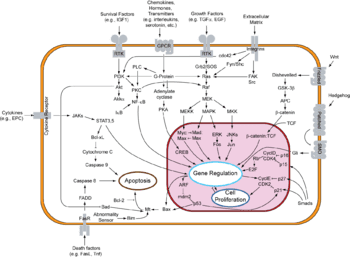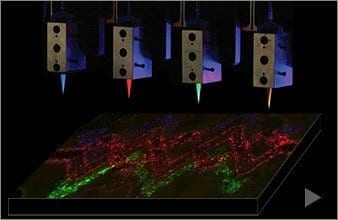
Researchers from the cancer nanotechnology and signal transduction and therapeutics programs of UCLA’s Jonsson Comprehensive Cancer Center (JCCC) have developed an innovative technique using light to carry chemotherapy safely to cancer cells.
Drs. Jeffrey Zink, professor of chemistry and biochemistry, and Fuyu Tamanoi, professor of microbiology, immunology and molecular genetics, and colleagues published their findings in the journal Small on February 20, 2014.
A light-activated drug delivery system is particularly promising, because it can accomplish spatial and temporal control of drug release. Finding ways to deliver and release anticancer drugs in a controlled manner that only hits the tumor can greatly reduce the amount of side effects from treatment, and also greatly increase the cancer-killing efficacy of the drugs. The difficulty of treating cancer often derives from the challenges of getting anticancer chemotherapy drugs to tumor cells without damaging healthy tissue in the process. Many cancer patients experience treatment side effects that are the result of drug exposure to healthy tissues.
A major challenge in the development of light-activated drug delivery is to design a system that can respond to tissue-penetrating light. Drs. Tamanoi and Zink joined their diverse teams and collaborated with Dr. Jean-Olivier Durand at University of Montpellier, France to develop a new type of microscopic particles (nanoparticles) that can absorb energy from tissue-penetrating light that releases drugs in cancer cells.
These new nanoparticles are equipped with specially designed nanovalves that can control release of anticancer drugs from thousands of pores, or tiny tubes, which hold molecules of chemotherapy drugs within them. The ends of the pores are blocked with capping molecules that hold the drug in like a cork in a bottle. The nanovalves contain special molecules that respond to the energy from two-photon light exposure, which opens the pores and releases the anticancer drugs. The operation of the nanoparticles was demonstrated in the laboratory using human breast cancer cells.
Because the effective depth range of the two-photon laser in the infrared red wavelength can reach four centimeters from the skin surface, this delivery system is best for tumors that can be reached within that range, which possibly include breast, stomach, colon, and ovarian cancers.
Another feature of the nanoparticles is that they are fluorescent and thus can be tracked in the body with molecular imaging techniques. This allows the researchers to track the progress of the nanoparticle into the cancer cell to insure that it is in its target before light activation. This ability to track a targeted therapy to its target has been given the name “theranostics” (a portmanteau of therapy and diagnostics) in the scientific literature.
“We have a wonderful collaboration,” said Zink. “When the JCCC brings together totally diverse fields, in this case a physical chemist and a cell signaling scientist, we can do things that neither one could do alone.”
“Our collaboration with scientists at Charles Gerhardt Institute was important to the success of this two-photon activated technique,” said Tamanoi. “It provides controls over drug delivery to allow local treatment that dramatically reduces side effects.”
The Latest on: Light-activated drug delivery system
[google_news title=”” keyword=”Light-activated drug delivery system” num_posts=”10″ blurb_length=”0″ show_thumb=”left”]
via Google News
The Latest on: Light-activated drug delivery system
- Bone and Spine Newson May 5, 2024 at 5:00 pm
The peptide has been used as a delivery vehicle ... a critical part of the body's immune system, an effect that is difficult to deliver with ... Spinal Cord Injury Causes Acute and Systemic ...
- Nanotechnology in Therapeuticson May 2, 2024 at 5:00 pm
Polymeric nanocarriers can be categorized based on three drug-incorporation mechanisms ... microwaves or laser light results in the destruction of healthy tissue surrounding the tumor.
- Stem Cells Newson April 29, 2024 at 5:00 pm
2024 — Researchers can use the light naturally thrown off by biological specimens to better study the different states of stem cells in the nervous system, ... Mar. 21, 2024 — Biomedical ...
- Mechanochemistry strips cargo molecules from a loaded rotaxaneon April 27, 2024 at 5:00 pm
This proof of principle suggests that the method might find use in an ultrasound-activated drug delivery system. For now, De Bo’s team is creating rotaxanes with more docking stations ...
- Drug Delivery Technologies market is projected to grow at a CAGR of 5.5% by 2034: Visiongainon April 26, 2024 at 6:15 am
Visiongain has published a new report entitled Drug Delivery Technologies Market Report 2024-2034: Forecasts by Route of Administration (Implantable Drug Delivery, Injectable Drug Delivery Nasal Drug ...
- Ultrasensitive photonic crystal detects single particles down to 50 nanometerson April 24, 2024 at 12:49 pm
Using an ultrasensitive photonic crystal, TU/e researchers were able to detect single particles down to 50 nanometers in diameter. The new research has just been published in the journal Optica.
- Microprinting millions of microparticles in the blink of an eye through multi-photon 3D laser printingon April 7, 2024 at 5:00 pm
Their high-precision system not only prints faster but also handles a wider range of materials, opening doors for diverse applications. The study, published in Light: Advanced Manufacturing ...
- From Lab to Launch: Successful Drug Development Strategies Using Lipid-Based Delivery Systemson March 14, 2024 at 8:00 am
Join experts to discuss the benefit of integrating formulation and manufacturing to enhance drug solubility and market speed with ... This webinar aims to simplify these complex scientific concepts ...
- Envarsus Xron January 30, 2024 at 3:01 pm
Such inhibition prevents the dephosphorylation and translocation of various factors such as the nuclear factor of activated T-cells (NF-AT) and nuclear factor kappa-light-chain-enhancer of ...
- Interview With Donald E Ingberon January 11, 2024 at 4:56 am
Inspired by this natural mechanism, we developed a shear-activated drug-delivery system. We used nanoparticles, approximately 180 nm in diameter, that are composed of US FDA-approved biodegradable ...
via Bing News










